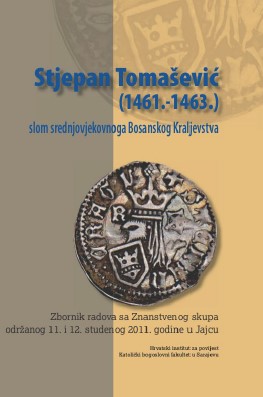O obitelji bosanskog protukralja Radivoja Ostojića (prilog rasvjetljavanju bračnih veza posljednjih Kotromanića s plemstvom iz dravsko-savskog međurječja)
On the Family of the Bosnian Anti-king Radivoj Ostojić: A Contribution to the Study of Marriages between the Last Members of the Kotromanić Dynasty and the Nobility from the Drava-Sava Interamnium
Author(s): Stanko Andrić
Subject(s): Cultural history, Political history, Social history, Culture and social structure , 15th Century, The Ottoman Empire
Published by: Hrvatski institut za povijest
Keywords: Kingdom of Bosnia; house of Kotromanić; Radivoj Ostojić; family of Velika (Velički Velikei); Catherine of Velika; County of Požega; Slavonia; Ottoman;
Summary/Abstract: The medieval Bosnian dynasty of Kotromanić, which gave the country most if not all of its bans and kings from the mid-thirteenth century on, established matrimonial relations with several high-ranking families from the kingdom of Hungary-Croatia, Bosnia’s northern and western neighbour. Besides the best-known marriage of Elizabeth, daughter of Ban Stephen II, to the Hungarian-Croatian king Louis I the Great, there were four other marriages between the members of the house of Kotromanić and the nobility of baronial rank from Croatia (Šubić of Bribir, Nelipčić of Cetina), Slavonia (Babonić of Vodica) and the eastern part of the Drava-Sava interamnium (Gorjanski/Garai). This paper aims to shed more light on the remaining and probably the least known case of this kind, i. e. the marriage between Radivoj Ostojić, son of King Ostoja and paternal uncle of the last independent king of Bosnia Stephen Tomašević, and Catherine of the family of Velika (Hung. Velike) from Požega county. Radivoj acted as an anti-king during the rule of King Stephen Tvrtko II (1421-1443) and he also claimed the throne at the beginning of the rule of his own brother Stephen Tomaš (1443-1461), until finally renouncing his royal ambitions in 1446. Since he actively entered the public and political sphere as early as in 1431, it is possible that he had been married to an unknown before 1449 when he got engaged to and expected to marry Catherine of Velika. The marriage was laid down in a contract concluded in that year between himself and Catherine’s father Nicholas. Nicholas and his wife Margaret gave their shares in the family estates of Velika and Petnja (Požega county) to Radivoj “of Vranduk” and his fiancée, while Radivoj gave them in return one half of his castle of Sólyomkő or Sokol (in Bosnia’s northern region of Usora). Nicholas did not belong to baronial elite, his family being only locally significant and, as owners of lands and castles, restricted to the county of Požega. He served as a vice-count in the counties of Baranja and Požega when these were administered by John of Korođ (Kórógy), Ban of Mačva. It is possible that Nicholas came into contact with Bosnia’s aristocracy while assisting John of Korođ in his political missions along the southern borders of the kingdom. In the later part of 1449, Radivoj Ostojić and Nicholas of Velika took under mortgage the castle and estate of Ljevač (county of Vrbas) from the members of the family of Nelepec of Dobra Kuća, a Slavonian branch of the prominent Bosnian family of Hrvatinić. Radivoj and Nicholas loaned 2 000 golden florins in cash and lands to the Nelepec family. In 1455 Nicholas of Velika left all of his possessions to his three daughters including Catherine, wife of Radivoj de castello Zalathnak (he did not appear with this designation anywhere else). The only information about Radivoj’s (and probably Catherine’s) children before the fall of Bosnia comes from the Dubrovnik archives, where an unnamed son (and in one case “sons”) of Radivoj were referred to in 1451, 1454 and 1455. The context of these mentions seems to suggest that he was (or they were) still very young, which would make it probable that Catherine was indeed his/their mother. Radivoj’s children (liberi) are also cursorily mentioned in a privilege granted to Radivoj and his family by Pope Pius II in July 1459. This act coincided with a Bosnian legation visiting the pope at Mantua; it is possible that Radivoj himself took part in he mission, shortly after he and his nephew, king’s son Stephen Tomašević, had surrendered the castle of Smederevo to the Ottomans. An important castle on the Danube, Smederevo was the last territorial remnant of the Serbian Despotate. The castle was acquired by the Kotromanić prince along with his appointment as a new despot of Serbia in March 1459. The succession was approved and supervised by the Hungarian-Croatian king Matthias Corvinus, who soon bitterly regretted it and accused the Bosnians of treason and a deal with the Turks.
Book: Stjepan Tomašević (1461.-1463.) - slom srednjovjekovnoga Bosanskog Kraljevstva - Zbornik radova
- Page Range: 109-132
- Page Count: 24
- Publication Year: 2013
- Language: Croatian
- Content File-PDF

